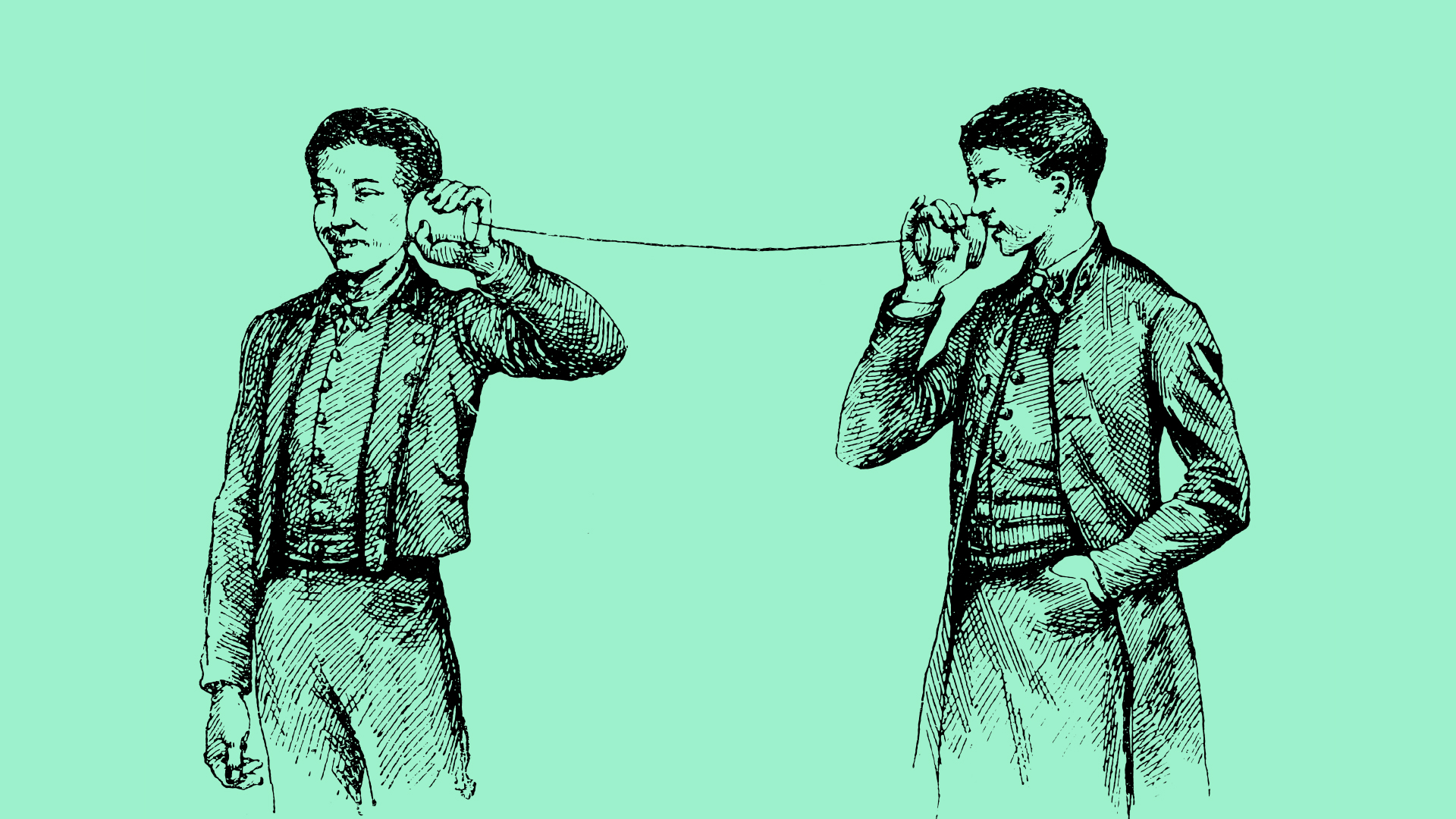Can You Hear Me Now?
Honing the Essential Skill of Listening
“Let every person be quick to listen, slow to speak. . . .”
“Can you hear me now?” The well-known refrain from the 2002 Verizon Wireless ad series in the United States was the hallmark of a new era of communication. Nearly 20 years later, wireless networks have expanded to accommodate almost every corner of the globe. Recent advancements in communication networks have provided us with a great opportunity to hear viewpoints from all over the world, at any time we choose—an unprecedented boon.
It’s troubling, then, that so many of us still feel so alone, so disconnected from one another. In 2017, US surgeon general Vivek Murthy declared a loneliness epidemic in the United States. And in 2018, the United Kingdom went so far as to appoint a minister for loneliness. They developed a “loneliness strategy,” not only to support meaningful relationships but, they hoped, to strengthen society itself.
Of course, it isn’t only familial and friendly relationships that have been unsatisfying. It’s apparent that, in spite of government attempts to address the problem, we also feel disconnected from our leaders, convinced that they really don’t hear us. This has led to a notable rise in conspiracy theories, the election of populist leaders, and increasingly polarized (and polarizing) political rhetoric.
One cause for this disconnection, both in our personal relationships and in broader society, is ineffective listening. As Kate Murphy describes in her recent book You’re Not Listening: What You’re Missing and Why It Matters, listening underpins our ability to feel connected. It’s a powerful tool to help us support and connect with loved ones, develop wisdom, empathize with different perspectives, and foster meaningful relationships.
“In modern life, . . . we are engaged in a dialogue of the deaf, often talking over one another at cocktail parties, work meetings, and even family dinners; groomed as we are to lead the conversation rather than follow it.”
Listening: Beneficial for You and Me
The act of listening deepens our connection to the other person and further supports our own sense of self and place in society. Of course, having someone to listen to us as we try to navigate life’s challenges is beneficial; it helps us process our circumstances in a healthy way. In fact, a 2007 study suggests that the presence of a listening partner also helps us gain more understanding, and its effects are longer lasting. Children showed increased problem-solving accuracy after explaining their solutions to a listening mother as compared to repeating them verbally to themselves.
Having someone to listen is obviously good for the speaker, but listeners also reap a benefit. According to Murphy, listening begets listening. When we allow others to confide in us, it gives us confidence that we have someone to confide in when life turns the tables. Surely a healthy, connected community is one where everyone feels they have someone who will listen. Indeed, a common trait of the Blue Zones, regions that are home to the world’s oldest populations, is the prioritizing of deep social connections; they regularly promote ways of sharing deeply personal insights, fears and emotions.
Surgeon general Murthy, when asked what he recommended to combat the loneliness epidemic, responded: “Sometimes we forget that one of the greatest gifts we can give other people is the gift of our full attention. I know we’re an action-oriented society. We’re used to thinking that the way to deal with a problem is to voice and enact a solution. But there’s also great healing to be found in listening deeply to someone. That’s something that we can do today, and it’s one of the most powerful things we can do.”
Listening has great potential for enhancing both our own well-being and our relationships; however, it is not an easy skill to master, and it’s one we rarely spend time honing.
What Makes Listening So Difficult?
Deep listening doesn’t come naturally to most of us. To begin with, the rate at which we process information is much faster than the rate at which a person can speak. This gap is called the speech-thought differential. The average English-speaking person converses at around 120–150 words per minute, which occupies only a fraction of our mental capacity. In the excess cognitive bandwidth, we allow ourselves to entertain other thoughts: what’s for dinner, the running to-do list, what time is the next appointment, etc. It takes skilled practice to stifle these internal interruptions and focus on the conversation at hand.
Further, modern life is filled with external distractions to keep us from listening fully. Interruption by notifications, or checking devices while someone is speaking, can interfere with our ability to communicate, connect and open up. Even the threat of interruption impacts our ability to meaningfully engage each other. A University of Essex study reported that just having a phone present at the dinner table increased feelings of disconnection and hesitation to talk about anything meaningful.
Another factor is that average conversation takes place at 60 decibels. So with baseline sound levels at restaurants averaging 80 decibels, we have to speak quite loudly in order to overcome music, background chatter and other ambient noise—a rather difficult way to have a meaningful conversation.
Beyond just the ability to transfer information, deep listening requires understanding the context. When the conversation turns to a more difficult topic where perspectives are varied and nuanced, it’s helpful to remember that we all have our own biases and perspectives.
Katherine Hampsten, associate professor of communication studies at St. Mary’s University in San Antonio, Texas, likens conversation to a game of catch with a lump of clay. When we speak, we throw the clay out into the discussion, and each of those who catch it will mold it slightly with their perceptions and then toss it back. Education, race, gender, age, frame of mind, connotation of words—all potentially influence how the clay is shaped. Two people may hear the same dialogue but come away with different interpretations of what was said, based on their own experiences.
“As the lump of clay goes back and forth from one person to another, reworked, reshaped, and always changing, it’s no wonder our messages sometimes turn into a mush of miscommunication.”
We also tend to find listening more difficult when someone has a different linguistic style. It’s easier to give more credence to people who speak like we do. For example, when company leadership fails to heed warnings issued by lower-level employees, differing linguistic styles are sometimes cited as the reason. Underlings may soften their approach so as not to come on too strong to their superiors; yet managers may not take their less-than-direct words very seriously and thus may fail to act on the problem at hand.
Linguistic styles can also vary based on gender; for example, women are more likely to express concerns and doubts, while men tend to minimize doubts. Men are also less likely to ask questions, as they are more attuned to perceptions of ineptitude. In the same way, race, heritage, region, education or any number of factors can influence linguistic styles.
More Than Active Listening
To remedy these challenges, many promote the concept of active listening, a term coined by psychologists Carl Rogers and Richard Farson in 1957. Their theory, however, is often misunderstood to be little more than maintaining eye contact, paraphrasing, and refraining from interruption. Such a checklist is about the things one does rather than the substance of one’s attitude. As Murphy explains, a skilled listener provides thoughtful, feeling responses and asks open-ended and other-directed questions that encourage the speaker to elaborate.
Part of the key to effective listening is being in a receptive state of mind. As Rogers describes it, “I hear the words, the thoughts, the feeling tones, the personal meaning, even the meaning that is below the conscious intent of the speaker.” This requires putting aside distractions, both internal and external, and using the speech-thought differential to support the speaker. We might note the body language and tone, or ask ourselves, “Why is this person telling me this?” or “What do they want me to know?”
Often, despite our best intentions, we shut down the speaker by offering unsolicited advice or by attempting to resolve the issue at hand. Sometimes this takes the form of suggesting we know how the other person feels, implying we can therefore solve their problem without asking for further information. Or we may minimize the other person’s perspective or try to force a positive perspective.
“We think we listen, but very rarely do we listen with real understanding, true empathy. Yet listening, of this very special kind, is one of the most potent forces for change that I know.”
Equally, we may ask questions that are effectively judgments: “Wouldn’t it be better to . . . ?” or “Don’t you think . . . ?” These types of responses don’t typically produce feelings of understanding, empathy and care between the listener and the speaker. Similarly, paraphrasing, nodding or parroting will prove ineffective if they come across as purely mechanical.
The speaker is more likely to feel understood and connected if we can respond thoughtfully and are able to communicate that we understand why the speaker is sharing this story. Honest and open questions can lay a foundation for deepening relationships; however, this is only true if we are genuinely interested in the response.

Listening and Disagreeing
It’s one thing to remain receptive to close friends and family members, but how do we feel around those who embrace different political views or life choices? Or those who challenge our carefully cultivated ideals or customs? Listening through disagreement can be extremely difficult, particularly if we have strong feelings and convictions about the subject matter. However, if we approach these difficult conversations as opportunities to learn more about the world or those we interact with, we may find solutions that are more inclusive and robust.
Recent studies suggest not only that few of us listen while disagreeing, but also that disagreement strongly correlates with fear. A 2016 Pew Research study found that in the United States, opposing political sides not only disagree but actually fear the opposing party, with 55 percent of Democrats being afraid of Republicans and 49 percent of Republicans being fearful of Democrats. A study from the Survey Center on American Life reported in June 2021 that 15 percent of Americans have actually ended a friendship over political differences.
Evidence supports the view that a fear-based response to ideological difference is biological. Neuroscientists at the Brain and Creativity Institute at the University of Southern California in Los Angeles found that attacks on strongly held convictions tend to inflame areas of our brain associated with emotion, such as the amygdala and the insular cortex. If our primary response to opposing views is fear, then it makes sense that political discourse has turned to such polarized rhetoric. But if each side is fearful of the other, how will they work together sufficiently to find a reasonable path forward?
“When we are in survival mode our reactivity makes it quite challenging, if not outright impossible, to be open and receptive to others.”
This is one area where listening thrives. There is an inverse relationship between amygdala activity and areas of the brain engaged during careful listening. Focusing on careful listening can help us to emotionally regulate and remain in a rational, thoughtful neural pathway. Not only does this help us listen to the other party, but people who do this on a regular basis are generally found to be more cognitively complex. They’re able to better store and retrieve information, produce new ideas, and make sounder judgments.
Listening to other viewpoints and allowing our convictions to be challenged can ultimately help us build more robust ideas. It also helps us recognize and cope with gray areas, incongruous ideas and nuance. This is only true, however, if we’re able to carefully listen, even through emotion and accusation. According to Rogers, this is a fundamental skill: “While I still hate to readjust my thinking, still hate to give up old ways of perceiving and conceptualizing, . . . I have, to a considerable degree, come to realize that these painful reorganizations are what is known as learning.”
Careful listening is driven by an attitude of curiosity and a generosity of spirit that acknowledges we might have something to learn. It does not mean that we have to agree with an opposing point of view, but it recognizes that we all share a common human experience and that others may have an interesting story about how they got to that position.
In the past few years, perhaps more than most, listening has fallen by the wayside while divisive memes, shouting over one another, and tone-deaf social media arguments have ruled the day. Increasingly we cut off relationships rather than seeking to understand or work through differences. The result has been division, disconnection, loneliness and depression.
What would the world look like if we all sought to engage each other as equals? Fundamentally, genuine listening requires placing value on the other person’s story and perspective. It compels humility and care toward the speaker, and a recognition that we might learn something about the world or the other person. These principles of empathy, tenderheartedness and humility are reminiscent of New Testament and other writings about promoting peaceful communities. Individually, we may not be able to solve the loneliness epidemic or heal political strife at a global scale. However, applying these principles of care for one another in our own lives could have positive impacts on our own spheres of influence.
Murphy sums up her book: “When you engage with someone, your behavior does two things: 1) it helps or hinders your understanding, and 2) [it] strengthens or weakens the relationship. Listening is your best bet on both counts.”


